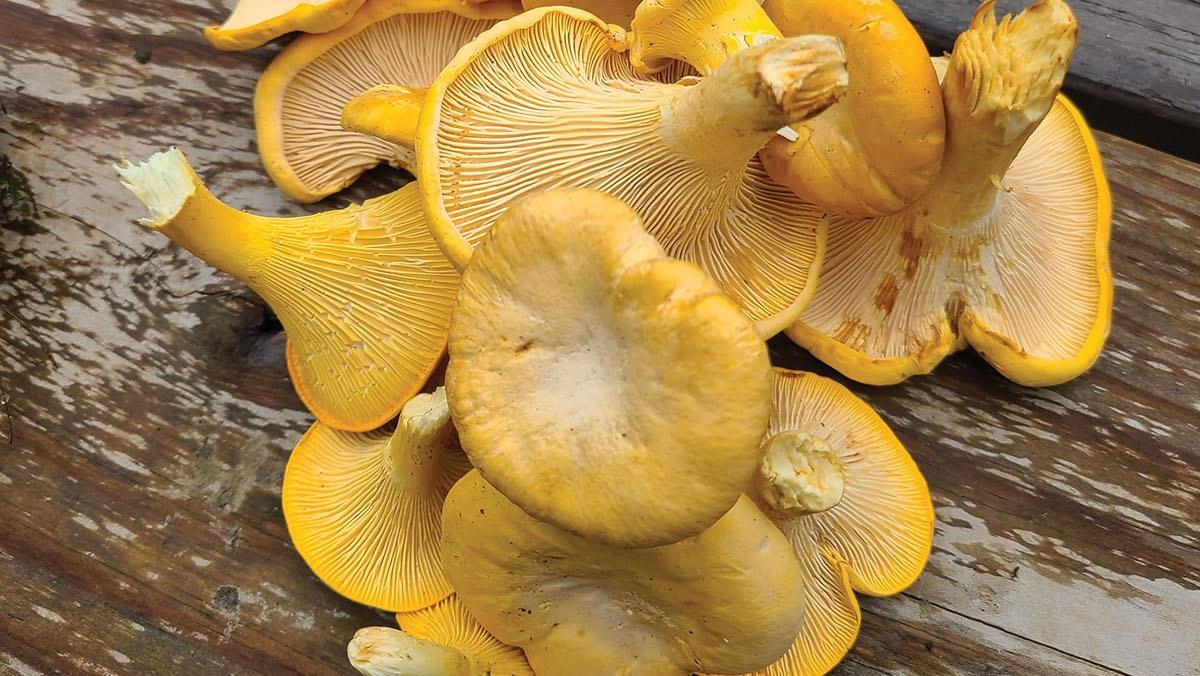Jessica Ross, a conservation biologist for the Wisconsin Department of Natural Resources, knew nothing about mushroom foraging before moving to Wisconsin. But trekking through forests in search of fungi was already in her DNA.
“I have family members going back generations who were mushroom hunters,” she says. “I always had a twinkle in my eye about mushrooms and [the Madison Mycological Society] helped me grow in my knowledge.”
That same curiosity drew Michael Marit of Sturgeon Bay, who is active with the Door Peninsula Mushroom Club, to mushroom foraging.
“I became attracted to mushrooms when I first started noticing how quickly they emerge from the forest floor and then disappear,” he says. “It was mysterious and something I wanted to understand better.”

What Marit particularly enjoys studying is the importance of mushrooms to our ecosystem, how plant roots and mushroom mycelium share nutrients, the potential for mushrooms to be used in bioremediation to remove pollutants, and mushrooms’ nutritional and medicinal benefits.
Most mushrooms are found either in soil or on wood, such as logs or trees, and some mushroom species grow only on particular tree species. Most edible mushroom species grow statewide, but some grow only in certain parts of the state.
Ross says fall is one of the best times for mushroom foraging in Wisconsin because there are lots of autumn species, like Hen of the Woods, Black Trumpet, and Golden Oyster. Some of the summer species, like Chicken of the Woods, are also still holding on—and due to their bright orange color, they are one of the easiest to identify. Chanterelles, too, can be found throughout the state.
Edible and inedible mushrooms from a Madison Mycological Society foray. Photo by Jessica Ross
“Think going from the dormancy of winter into spring, and going from hot summer to cooling off into the fall,” says Marit. “Rain and moisture are other key elements for mushrooms to be abundant.”
Both Ross and Marit credit local mushroom clubs for keeping them safe—knowing what’s poisonous and what’s the real deal—and inviting them on mushroom hunts, also known as forays.
A common question for new foragers is where to go. “Any forested area would be good for mushroom hunting,” says Ross, who will even hunt at parks within a mile of her Madison home. It doesn’t have to be a state park or national forest.
For new mushroom foragers, Ross suggests beginning with easy-to-identify mushrooms, like morels or oysters, as they don’t have poisonous look-alikes. And while mushroom hunting might seem like an ideal meditative, solo activity, taking a more seasoned hunter with you is a good idea.
“You’ll have people who have been doing it for years and years,” says Ross, adding that experienced foragers can show you different species and the habitats where each kind is usually found.
In addition to forays, local clubs often host workshops and lectures.
“Our focus is on education, celebration, and building community around mushrooms,” says Marit. “We teach how to cultivate mushrooms at home (indoors or outdoors), how to use mushrooms in art, how to cook with them, and safe and responsible foraging.”
Once mushrooms are foraged and are sitting in one’s kitchen, what are some good recipes? Ross suggests looking to the mushroom species for inspiration.
“A lot of mushroom names have this meat analog and can be used as a meat substitute,” she says. “For example, Chicken of the Woods can be battered and fried, like chicken fingers.”
If blessed with an abundance of mushrooms, many foragers cook and freeze them, or dehydrate or pickle.
But should a hunt not prove to be very fruitful, don’t fret.
“I’ve noticed more high-end mushrooms, like Lion’s Mane, Maitake, and Shiitake, are showing up in the grocery stores,” says Marit.
To receive maximum nutrition, don’t eat a mushroom raw. “Raw mushrooms are hard for your body to break down,” says Marit. “The heat of cooking helps to break down the mushroom for better digestion.”
The public’s increasing interest in and appetite for mushrooms means knowledge about them will continue to grow.
“A decade or two ago it would have been much harder to know what to do with mushrooms in cooking,” says Marit. “But, especially in the last couple of years, more people are learning about mushrooms and using them in all sorts of creative ways in the kitchen.”
Like many mycological groups, the Door Peninsula Mushroom Club holds forays and events throughout the year. Photo by Michael Marit
Want to learn more about mushrooms and foraging?
Check out these Wisconsin organizations’ websites and Facebook groups:
Door Peninsula Mushroom Club
doorpeninsulamushroomclub.carrd.co, facebook.com/DPMushroomClub
Fungal Biology Supergroup at UW–Madison
Madison Mycological Society
madisonmycologicalsociety.com, facebook.com/MadisonMycoSociety/
Northwestern Wisconsin Myco Enthusiasts
facebook.com/groups/667766437208263
UW–La Crosse Mycology Club
Wild Food Wisconsin
facebook.com/groups/1509621176012491/
Wisconsin Mycological Society
wisconsinmycologicalsociety.org, facebook.com/wismycosociety





